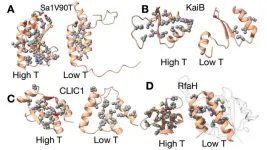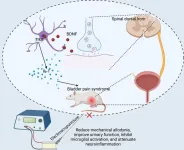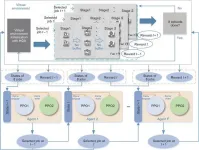(Press-News.org)
Metamorphic proteins can be thought of as the “shapeshifters” of human, animal and bacterial cells. Their ability to drastically switch between two different shapes enables them to adapt to changing environments and carry out diverse functions.
Little is known about how metamorphic proteins transform despite their usefulness in living organisms. To help tackle this mystery, a new paper in the “Perspectives” section of the journal Proceedings of the National Academy of Sciences (PNAS) offers a “bold theory,” said co-author John Orban, a professor in the University of Maryland’s Department of Chemistry and Biochemistry and Institute for Bioscience and Biotechnology Research (IBBR).
Orban and his co-author Andy LiWang, a professor of chemistry and biochemistry at the University of California, Merced, suggest that many metamorphic proteins have an “underlying temperature dependence.” If confirmed, this would mean that temperature—and cold temperature in particular—plays a fundamental role in setting off shapeshifting in metamorphic proteins.
Ultimately, a better understanding of metamorphic proteins could advance biomedical research and the development of lifesaving drugs.
“It may be possible to design proteins that are switchable and have more than one function,” Orban said. “They could potentially be stealth proteins that go into a cancer cell and pretend to be one state, but under certain environmental conditions switch to a state that could kill the cell, for example.”
Metamorphic proteins are known to change shape in response to various environmental “triggers”—such as changes in acidity or oxidation—but Orban’s and LiWang’s theory takes this one step further. Their research seeks to explain why an equilibrium, or balance, exists between the various shapes that metamorphic proteins can take.
“Metamorphic proteins can't shapeshift unless there's an equilibrium between the two states and our hypothesis is that the underlying reason for that equilibrium is based on temperature,” Orban said. “We think this may be some sort of universal mechanism.”
Orban said this hypothesis was inspired by an earlier study he co-authored in 2023. That paper revealed that an engineered metamorphic protein switched back and forth between folded states when researchers adjusted the temperature over a “relatively narrow” range between 5 and 30 degrees Celsius.
“There are now some other examples out there of naturally occurring metamorphic proteins that do this, but this was the first example of a designed protein that switches reversibly using only temperature,” Orban said. “Andy and I started talking more and wondered whether other metamorphic proteins followed the same pattern.”
In their new PNAS paper, Orban and LiWang surveyed 26 pairs of metamorphic proteins that have been studied before, though never with this temperature dependence theory in mind. Specifically, the researchers analyzed differences in hydrophobic contacts—water-repelling zones that help keep structures together—from one protein state to the next.
Where experimental data was available, the researchers found that nearly every protein pair had significant differences in hydrophobic contacts and that these differences were closely linked to temperature-dependent changes. Low temperature states were associated with fewer hydrophobic contacts, resulting in a more flexible state that can be conducive to shapeshifting.
The evidence uncovered so far seems to back up their theory on the role of temperature in shapeshifting proteins.
“It’s a working hypothesis, but so far it’s been supported,” Orban said. “We were surprised because we thought this was a pretty bold idea.”
Going forward, this research could be applied to the search for more metamorphic proteins, which are difficult to identify. The global Protein Data Bank contains about 200,000 known monomorphic proteins—those with a single, stable structure—but fewer than 100 metamorphic proteins. By using temperature as a trigger, Orban believes that some proteins believed to be monomorphic might transform, revealing their true nature as metamorphic proteins.
While Orban’s main motivation is to answer questions about the underlying mechanisms that trigger shapeshifting proteins, he’s also optimistic about the future applications.
“Our interest so far has been mostly fundamental, but we talk about possible biotechnology applications and I don't think it's pie in the sky,” Orban said. “I think it's entirely possible that in the not-too-distant future we will be predicting metamorphic proteins more reliably, designing them and putting them to work for us.”
###
Their paper, “Unveiling the Cold Reality of Metamorphic Proteins,” will be published in PNAS on March 14, 2025.
This research was supported by the National Institutes of Health (Grant Nos. R35GM144110 and R01GM062154), the U.S. Army (Grant No. W911NF-23-1-0248) and NSF-CREST: Center for Cellular and Biomolecular Machines at the University of California, Merced (Award No. NSF-HRD-1547848). The University of Maryland NMR Facility at IBBR is also supported by the National Institute of Standards and Technology and a grant from the W. M. Keck Foundation. This article does not necessarily reflect the views of these organizations.
END
March 10, 2025 — Perinatal interventions guided by reproductive justice principles can have positive effects on the perinatal mental health of Black birthing patients and, perhaps, the mental health development of their infants, states a systematic review published in a special issue of Harvard Review of Psychiatry, part of the Lippincott portfolio from Wolters Kluwer.
Mental health interventions incorporating reproductive justice principles "utilize a trauma-informed approach to address the psychosocial stress and trauma of racism and their negative effects on pregnant parents and offspring," Cristiane S. Duarte, PhD, MPH, of Columbia University ...
Herpes simplex virus-1 (HSV-1) is commonly known for causing blisters and sores. But in some cases, the virus can migrate to the eye or nervous system, causing severe, chronic symptoms.
Now, a study from University of Illinois Chicago researchers finds that herpes infection through the nose can lead to anxiety, motor impairment and cognitive issues. The research is the first to show that, by exploiting a cellular enzyme, the virus can produce behavioral symptoms. The finding emphasizes the need for prevention and treatment of a virus carried by billions of people worldwide.
The research, published in mBio, is the latest from the College of Medicine group ...
Despite its increasing prevalence, a painful condition called bladder pain syndrome, or interstitial cystitis, remains understudied with limited treatment options. In a new eNeuro paper, Min-Zhi Su and colleagues, from Sun Yat Sen University, used a rat model of bladder pain syndrome to explore if electroacupuncture can alleviate pain and improve bladder function. Electroacupuncture nerve stimulation therapy has shown promise in treating conditions like Huntington’s disease and Amyotrophic Lateral Sclerosis, but researchers have not explored its utility in this context. The researchers discovered that this ...
Many psychiatric disorders are linked to altered functioning of brain networks that drive reward processing and executive functions like making decisions, taking risks, planning, and memory. But a better understanding of how these networks typically develop to support reward-related executive functions is needed. New in JNeurosci, Samuel Klein and Monica Luciana, from the University of Minnesota, led a longitudinal study to explore how brain networks for reward processing and executive functioning ...
The Camden Study, a pregnancy cohort of 4,765 women recruited between 1985 and 2006 from one of America’s poorest cities, has found new life at Rutgers University – where it promises to unlock critical insights into maternal and child health for researchers worldwide.
According to a recent paper in Nutrients, the project was designed to study nutritional status in adolescent pregnancies but expanded into a comprehensive repository of maternal and infant health data that yielded more than a decade of significant ...
Currently more than 8,000 satellites are orbiting at altitudes of between 300 and 1000 km in the Earth’s upper atmosphere – also called the thermosphere. While changes in space weather, such as coronal mass ejections and solar flares, can cause temporary changes in the density of this region, scientists at the University of Birmingham suggest the effects caused by global warming are likely to be much longer term.
This is because of the effects caused by greenhouse gases (GHGs) ...
MIT aerospace engineers have found that greenhouse gas emissions are changing the environment of near-Earth space in ways that, over time, will reduce the number of satellites that can sustainably operate there.
In a study that will appear in Nature Sustainability, the researchers report that carbon dioxide and other greenhouse gases can cause the upper atmosphere to shrink. An atmospheric layer of special interest is the thermosphere, where the International Space Station and most satellites orbit today. When the thermosphere contracts, the decreasing density reduces atmospheric drag— a force that pulls old satellites and other debris down to altitudes where they will ...
A mysterious phenomenon at the centre of our galaxy could be the result of a different type of dark matter.
Dark matter, the mysterious form of unobserved matter which could make up 85% of the mass of the known universe, is one of science’s biggest manhunts.
In this first of its kind study, scientists have taken a step closer to understanding the elusive mystery matter. They believe a reimagined candidate for dark matter could be behind unexplained chemical reactions taking place in the Milky Way.
Dr Shyam Balaji, Postdoctoral Research Fellow at King’s College London and one of the lead authors of the study explains, “At the ...
Phase transitions, like water freezing into ice, are a familiar part of our world. But in quantum systems, they can behave even more dramatically, with quantum properties such as Heisenberg uncertainty playing a central role. Furthermore, various spurious effects can cause the systems to lose, or dissipate, energy to the environment. When they happen, theses “dissipative phase transitions” (DPTs) push quantum systems into new states.
There are different types or “orders” of DPTs. First-order DPTs are like flipping a switch, causing abrupt jumps between states. ...
A recent study published in Engineering presents a significant advancement in manufacturing scheduling. Researchers Xueyan Sun, Weiming Shen, Jiaxin Fan, and their colleagues from Huazhong University of Science and Technology and the Technical University of Munich have developed an improved proximal policy optimization (IPPO) method to address the distributed heterogeneous hybrid blocking flow-shop scheduling problem (DHHBFSP).
The DHHBFSP is a complex optimization challenge in manufacturing. In distributed manufacturing settings, jobs with diverse requirements arrive randomly at different hybrid flow shops. These shops have varying numbers of machines ...



